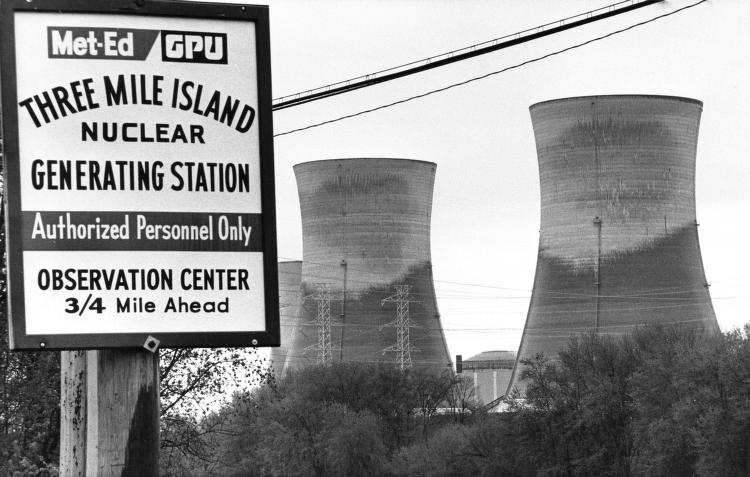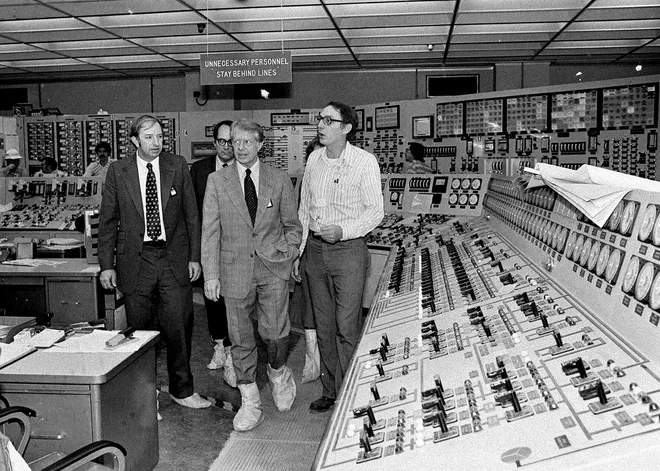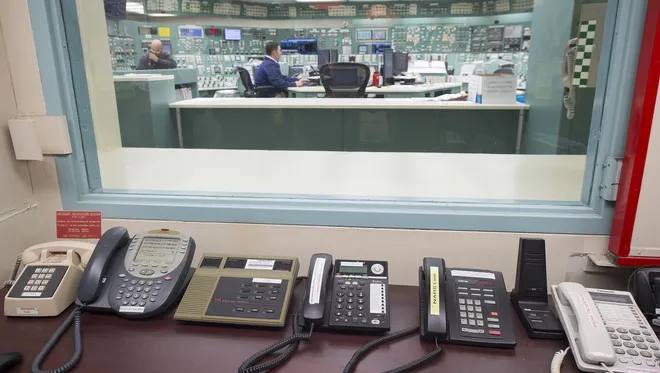
Three Mile Island and Gov. Dick Thornburgh: A Crisis, A Leader, and a Legacy
- Debbie Brown

- Apr 8
- 6 min read
Governor Richard "Dick" Thornburgh’s legacy is marked by his steady leadership during one of the most harrowing crises in U.S. history—the Three Mile Island nuclear accident. After taking office in January 1979, Thornburgh was soon faced with an unprecedented emergency that required swift decision-making, clear communication, and a focus on public safety. Gov. Thornburgh's response to the March 28, 1979 emergency, a partial meltdown of Reactor Number 2 at the Three Mile Island Nuclear Generating Station, demonstrated his ability to manage chaos with composure and foresight. By prioritizing transparency, consulting with experts, and making difficult yet necessary choices, Thornburgh’s actions became a model for crisis management.
This post examines the events of the Three Mile Island incident, the effects it had on the nuclear industry and public perception, and the role of government intervention. It particularly highlights Governor Thornburgh’s leadership, exploring how his response not only helped mitigate immediate dangers but also cemented his reputation as a pragmatic and effective leader in times of uncertainty.
What Happened?
The incident at Three Mile Island, a nuclear power plant located on an island on the Susquehanna River, just south of Harrisburg, began with a minor malfunction in the secondary cooling circuit, which caused a rise in the temperature of the reactor’s coolant. A relief valve designed to release excess pressure failed to close, allowing radioactive coolant to escape. Operators misinterpreted the situation due to inadequate training and flawed instrumentation, which led to further actions that exacerbated the problem. Ultimately, the reactor core overheated, causing a partial meltdown.

Although the containment structure prevented significant amounts of radioactive material from being released into the environment, small amounts of radioactive gases were discharged, causing alarm among the local population and beyond.

Effects of the Incident
The immediate health effects of the Three Mile Island accident were minimal, with no confirmed deaths or injuries resulting from radiation exposure. However, the psychological impact was profound, as the incident eroded public confidence in nuclear energy. Local residents reported high levels of stress and anxiety, and some expressed concerns about potential long-term health risks, though studies conducted in subsequent years have not shown significant increases in cancer rates or other health issues linked to the incident.
Economically, the accident was devastating for the plant’s operators. Cleanup efforts took over a decade and cost approximately $1 billion. Moreover, the accident led to stricter regulatory standards for the nuclear industry, which increased operational costs and delayed the construction of new plants.
Government Response
The federal government’s response to the crisis was multifaceted. The Nuclear Regulatory Commission (NRC) played a central role in assessing the damage and implementing new safety regulations. President Jimmy Carter, who had a background in nuclear engineering, visited the site to reassure the public about the situation’s stability.

One of the most critical aspects of the response came from Pennsylvania’s Governor Dick Thornburgh. In the early hours of the incident, Thornburgh prioritized clear communication with the public. He ordered the evacuation of pregnant women and young children within a five-mile radius of the plant as a precautionary measure. Thornburgh’s calm and measured response earned him praise for managing the crisis effectively under chaotic circumstances.
Governor Richard Thornburgh's Response
Thornburgh coordinated his response with federal and state agencies,
including the Nuclear Regulatory Commission, the Pennsylvania Emergency Management Agency, and the White House. He relied on expert advice from his administration and outside consultants to navigate the crisis. His administration worked closely with Harold Denton, the NRC’s point person on-site, ensuring transparency and informed decision-making.

Thornburgh’s immediate actions focused on public safety and clear communication. He advised residents to stay informed and avoid panic, while also taking decisive action by ordering the evacuation of vulnerable populations. He maintained frequent press briefings, reinforcing the importance of accurate information in preventing mass hysteria. His cautious and science-driven approach reassured many Pennsylvanians during a time of fear and uncertainty.

The press widely lauded Thornburgh’s handling of the crisis, often contrasting his calm leadership with the confusion initially seen at the plant itself. Media outlets praised his reliance on expert advice and his ability to manage communication effectively. His response set a precedent for crisis management, demonstrating the necessity of transparency and proactive decision-making in handling nuclear and other large-scale emergencies.
Thornburgh remained actively involved in the aftermath of the Three Mile Island accident well beyond the initial crisis, demonstrating a long-term commitment to public safety, environmental health, and regulatory accountability.
After the partial meltdown in 1979, Thornburgh maintained oversight of the cleanup process throughout the remainder of his time as governor (until 1987). He ensured that the cleanup of TMI Unit 2 was conducted under strict safety standards, regularly pressing the Nuclear Regulatory Commission (NRC) and plant operators for transparency and thoroughness. His administration closely monitored the decontamination work, which lasted over a decade and cost around $1 billion.
Thornburgh emphasized protecting residents from any additional exposure to radiation and demanded clear communication from federal agencies and utility companies.
Even after leaving office, Thornburgh continued to advocate for strong nuclear safety regulations. He frequently spoke about the lessons learned from the TMI incident, emphasizing the need for improved emergency preparedness, inter-agency cooperation, and public communication. In his autobiography, Where the Evidence Leads (1984), he reflected on the complexities of managing the crisis and its aftermath, highlighting how it shaped his understanding of responsible governance.
Thornburgh’s ongoing engagement helped ensure that the cleanup process remained a priority and contributed to long-term policy reforms in nuclear safety, emergency management, and state-federal cooperation. His role became a lasting part of the narrative surrounding Three Mile Island and nuclear regulation in the United States.
Remaining Challenges
Despite the passage of decades, the legacy of the Three Mile Island accident persists. Reactor TMI-2 has remained in a state of monitored storage since its closure in 1979, with full decommissioning delayed until the adjoining Reactor TMI-1, which ceased operations in 2019, can also be dismantled. The long-term storage and disposal of radioactive materials remain unresolved challenges, both for Three Mile Island and the nuclear industry at large.

Public skepticism toward nuclear energy, fueled in part by this incident, continues to influence energy policy. While some advocate for nuclear power as a low-carbon solution to climate change, others point to the risks highlighted by Three Mile Island as a reason to pursue alternative energy sources.
Conclusion
The Three Mile Island accident was a pivotal moment in U.S. nuclear history, exposing weaknesses in safety protocols and operational oversight. While the incident itself did not result in mass casualties, its psychological and economic consequences were profound. The response by Thornburgh was instrumental in preventing widespread panic and ensuring a controlled approach to crisis management. His reliance on expert advice, clear communication with the public, and decisive evacuation measures showcased his leadership under pressure.
The accident became a defining moment in Thornburgh’s political career, significantly influencing both his tenure as governor and his broader legacy. His calm, science-based, and transparent response to the nuclear crisis earned him national praise and established him as a capable and steady leader during a period of intense uncertainty. The way he handled the incident helped him gain the trust of the public not just in Pennsylvania, but across the country, bolstering his credibility as a crisis manager.
Thornburgh’s leadership during the crisis contributed to his landslide re-election in 1982, reinforcing his image as a responsible and competent executive. It also positioned him as a prominent figure in the national Republican Party. His reputation for sound judgment and public safety advocacy made him a natural choice for federal appointments; in 1988, President Ronald Reagan appointed him as U.S. Attorney General, a role he continued under President George H. W. Bush. In that position, he focused on issues such as white-collar crime, drug enforcement, and justice system reforms.
The legacy of his response to Three Mile Island remained a cornerstone of his public service narrative. It demonstrated the value of evidence-based leadership and effective communication, lessons he carried into his later roles. Even decades later, his performance during the crisis is cited in political and academic discussions as a model of how governors can manage large-scale emergencies with composure and clarity.
To view our selection of books and other resources featuring Gov. Thornburgh, Three Mile Island, and Nuclear Energy, click here.
References
Goldhaber, M. K. (1986). Cancer Mortality and the Three Mile Island Nuclear Accident: A Public Health Concern. American Journal of Public Health, 76(6), 683-684.
Nuclear Regulatory Commission (NRC). (n.d.). Backgrounder on the Three Mile Island Accident. Retrieved from https://www.nrc.gov
Thornburgh, D. (1984). Where the Evidence Leads: An Autobiography. University of Pittsburgh Press.
Walker, J. S. (2004). Three Mile Island: A Nuclear Crisis in Historical Perspective. University of California Press.



Comments